Looking for an adrenaline packed water sport that seems to almost combine skiing or surfing?
Then check out wakeboarding, where a rider is tied to a boat that tows them as they glide over water with the wakeboard.
The feet are strapped on the board with straps to allow the rider to perform clever tricks and turns (well, maybe once you get a bit more experienced on the board).
This exciting sport was established in the 80s and from then has developed to be embraced in the leading sports platforms such as ESPN.
If you’re just getting into wakeboarding, then you’ll benefit from our in-depth discussion of factors to consider when buying a wakeboard.
Top 10 Best Wakeboards for Beginners
| PHOTO | MODEL | EDITOR NOTES |
|---|---|---|
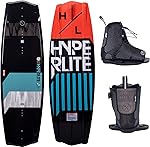 |
Hyperlite State 2.0 Mens Wakeboard 145 W//Remix Bindings | #1 Pick for Beginners |
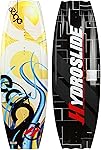 |
Hydroslide Edge Jr. Wakeboard Kids | #1 Pick for Kids Wakeboard |
 |
Hyperlite Scandal Wakeboard Womens | #1 Pick Best Wakeboard for Women |
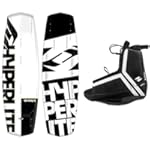 |
Hyperlite Agent 2021 Wakeboard Package | Best Value Package |
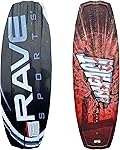 |
RAVE Sports Impact Wakeboard with Charger Boots | Best Cheap Wakeboard |
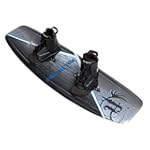 |
Full Throttle Aqua Extreme Wakeboard w/ Lace-Up Boots | |
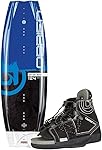 |
O’Brien System Wakeboard with Clutch Boots | |
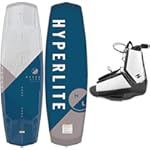 |
Hyperlite Wakeboard Package 2021 Vapor Destroyer/td> | |
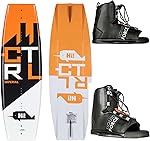 |
CTRL Imperial Wakeboard + Liquid Force Element Mens Bindings | |
What To Consider Before Buying
The factors can be broadly categorized into two while considering the skill of the rider and the style of riding.
Though we assume that you are new to this exciting water sport, we’ll still go over the considerations for beginner and intermediate wakeboard shoppers.
Then, well also point out other factors and features that you will want to consider as you compare the top wakeboards on the market.
As you might expect, wakeboards come in different shapes, sizes, and designs. And knowing which one is a good choice for you can be confusing, so let us help you out.
Ability of the rider
Usually, most of the boards apply to various niches. However, there are some that are perfect for the riders who are just starting out.
The beginner boards are usually cheaper and less complicated because they do not perform sophisticated tricks.
Most are crafted to provide better stability and control needed by the starters.
The characteristics include long boards which have square rails.
The only con of these boards is that they aren’t suitable for stunts, meaning as you advance, you will have to upgrade to a much complex board.
They are usually smaller and lighter for more flexibility.
The Riding Style
The wakeboarding fans tend to have had a background in either snowboarding or skateboarding.
Those who had been surfing or snowboarding can go for the single-tip boards with a tapered front and a square rear design.
These types can go in only one direction.
The skateboarders, on the other hand, will feel more comfortable in the twin-tip model since they have already mastered the dynamics of switching from the left to the right foot.
The twin-tip can perform simple landing tricks and can go in whichever direction.
After looking at this broad categories, we can now go into the details of each board to know which one you can buy.

The Board Length
This is one of the vital factors to consider. The length of the board should be proportional to the weight of the rider.
Normally, each specific wakeboard has its specific sizing markers for the weight of the rider.
That is to provide proper buoyancy while riding.
There is a chart in every wakeboard shop matching the rider weight and the length of the wakeboard.
For instance, those weighing
- 25 to 90 lbs should buy 111-130cm long boards
- 90-150 lbs for 130-130cm
- 150-225 lbs for 135-146cm
- above 225 lbs should get boards longer than 146cm
The Board’s Rocker
The rocker, also known as the rocking curve, is the shape of the bottom of the wakeboard.
Continuous rockers have a smooth fluid and a curved shape.
They provide you with a fast, smooth ride allowing you to maneuver and make great turns.
When popped, by hitting the wake/tail, it gives you a more predictable flight onto the flats. Continuous rockers are perfect for the less turbulent mornings.
Three stage rockers are divided into three breaks making three planes.
The center of the rocker is flat to allow more control as one glides over rails.
This shape offers the best dynamics for a perfect pop.
They are much slower because they disrupt water flow. Hybrid rockers are like a fusion of 3-stage rockers and continuous ones.
The center is slightly curved more than the three-stage rockers providing a smoother ride but still able to perform pops.
Material of the board
The wakeboard materials are selectively chosen to provide the desired functionality.
The preferred material should be light to allow riders to make jumps and perform tricks.
At the same time, they should be strong enough not to break when popped. Two primary materials preferred are foam board and honeycomb.
For more turbulent waters, professional riders opt for foam boards because of their flexible nature. They also ride slightly deeper hence are more stable.
Honeycomb, on the other hand, are much lighter and faster; hence they provide more pop. They can’t be used in rough waters because they are less flexible.
The Bindings on the Board
Bindings are the materials that are used to strap the rider onto the board. They also have specifications to meet such as flexibility, fit, and features.
The fit should be snug to hold the rider firmly, though not too tight to hurt the leg or prevent circulation.
They might be a little uncomfortable when fresh from the market; hence a lubricant may be necessary when fitting into the bindings.
The flexibility of the bindings will depend on the riding style of the rider.
For fast riders, tighter bindings are perfect as opposed to the stunt riders who require softer or flexible bindings.
When considering features, there are the closed tip bindings that provide a tighter grip hence more control and leverage.
They are slightly more expensive than the open ones. The open toe bindings which are cheaper offer great heel and toe work when doing tricks.
Other features of bindings include the type of closure, are they lace type, mechanical clanks, Velcro straps or buckle hinges.
In this section, the criteria for choosing should be the riders’ preference and experience with wakeboards.
Wakeboard Fins
Various types of wakeboards exist in the market some with fins and others lacking fins.
They play a role in keeping the board moving in the direction of the tip.
For beginners, the tips are much wider and larger to maintain control and balance in turbulent waters.
Professionals prefer thinner and narrower fins to enhance control while still providing room to perform stunts.
Some wakeboards also have spines, particularly the V-shaped spines.
These spines help in softening the landing allowing the rider to roll from one edge to the other.
They are mostly common with the 3stage rocker wakeboards to facilitate landing.
Wakeboard Edges
Some wakeboards have sharper edges and tails to facilitate aggressive tracking providing better acceleration and top speed.
However, they may be disadvantageous in that it is easy for them to catch an edge leaving you tumbling face forward.
Rounder edges are much lenient though and are perfect for surface tricks.
For hard and aggressive rip curves, the sharp edges are an excellent choice.
Other integral features
Channels are extrusions like elongated fins at the bottom of the wakeboard for breaking the surface tension of the water surface before the whole board glides on it.
Another feature is the grind base which was recently introduced with the evolution of the rail riding.
This trick in wakeboarding needs tough, durable bases to make up for the wear and tear that occurs when wakeboarding on docks, PVC or metal surfaces.
Having looked at these factors, you can evaluate your skills and make a choice of wakeboards discussed in this article.
For beginners, specifications for a proposed wakeboard include continuous rocker, rounded tips, round edges, broad and thick fins as well as a closed binding.
Such a board will provide you with a basic riding on smooth water or slightly rough turbulence.
